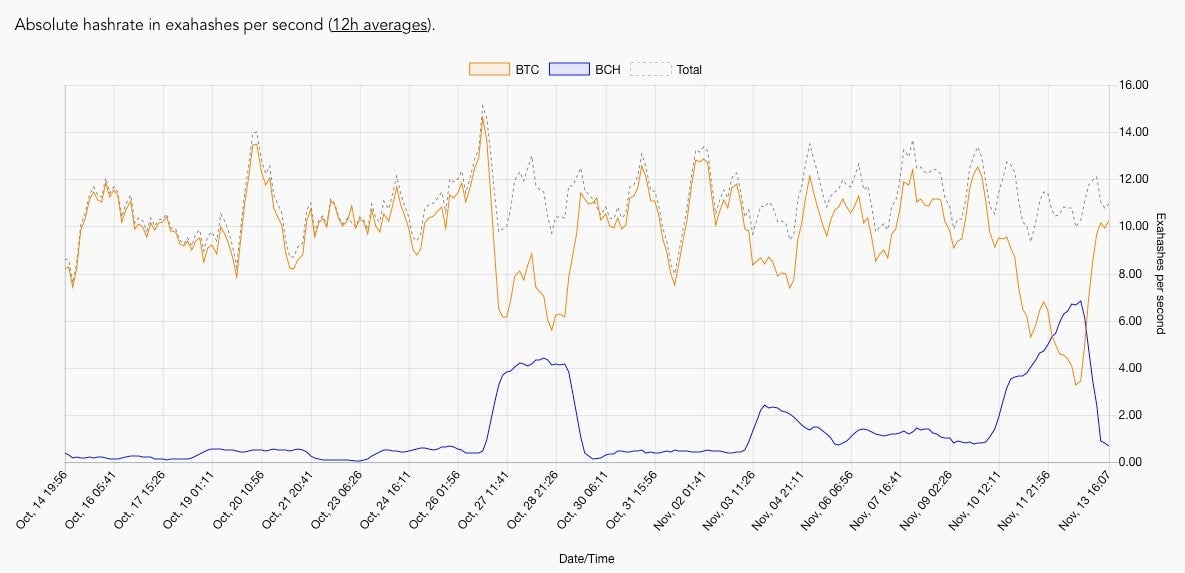One metric is far more important to bitcoin users than its price
Bitcoin’s price fell over the weekend—while the price of an offshoot, bitcoin cash, soared. The rally in bitcoin cash was so bullish that it even briefly surpassed another cryptocurrency, ethereum, in total market value, at $29.9 billion.


Bitcoin’s price fell over the weekend—while the price of an offshoot, bitcoin cash, soared. The rally in bitcoin cash was so bullish that it even briefly surpassed another cryptocurrency, ethereum, in total market value, at $29.9 billion.
While the bitcoin and bitcoin cash price action is exciting, investors in either would do well to pay attention to another critical metric: the amount of computational power committed to mining each digital coin, also known as the hash rate. A steep and prolonged drop in bitcoin’s hash rate could set off a much-feared “chain death spiral” that could render the bitcoin network useless. Bitcoin showed signs of its potential for triggering this dynamic over the weekend, when its hash rate fell by 50%.
How does a death spiral work? The bitcoin network currently adds a new bundle of transactions, known as a “block,” roughly every 10 minutes. The exact time is determined by how long it takes for a bitcoin miner to process a block of transactions. This, in turn, is set by something called the “difficulty” on the bitcoin network. Difficulty automatically adjusts itself to match the hash rate so that transactions won’t take too long.
But bitcoin’s difficulty only adjusts every 2,016 blocks, or roughly every two weeks. So if the hash rate suddenly plummets, the difficulty could be rendered too high for the amount of processing power on the network. This in turn could mean severe delays in completing bitcoin transactions. As transactions start getting delayed, the network’s utility is reduced and investors could start dumping bitcoins, causing the price to drop. Miners, in turn, could start mining other coins because a lower bitcoin price means mining is less profitable.
And so the cycle would continue, with investors and miners abandoning bitcoin, causing greater delays in transaction times, and preventing a difficulty adjustment from happening quickly enough to break the cycle. “Transactions get backlogged to a point where the coin becomes basically useless,” says Peter Kim, who co-founded a developer tool called Nitrous and is now working on an app for the cryptocurrency markets.
Think the death-spiral scenario sounds far-fetched? It came close to happening over the weekend. Bitcoin’s hash rate fell by 50% over two days as miners switched their machines from bitcoin to bitcoin cash, because it was more profitable to do so. The drop in the hash rate meant that the average time taken to complete a bitcoin transaction doubled from 10 minutes to 20 minutes or more, according to bitcoin analyst Jimmy Song. This coincided with a more than 20% crash in bitcoin’s price. “Bitcoin cash was up to 100% more profitable to mine because of the price run-up,” Song says.
Ironically, bitcoin was saved by bitcoin cash’s own difficulty increases. The algorithm governing difficulty adjustments on bitcoin cash caused a surge in the difficulty, making the coin less profitable to mine. The bitcoin cash people didn’t want volatile hash rates in their cryptocurrency, so they changed the protocol’s difficulty adjustment rules on Nov. 13. By this time, many miners had already switched their hash power back to bitcoin.
According to the hash rate monitor at Fork.lol, bitcoin’s hash rate has recovered to about 20 percentage points from where it was before it crashed. Bitcoin’s hash rate is once again well above that of bitcoin cash. A death spiral was averted.

Bitcoin watchers don’t expect to see the last of this sort of volatility in hash rate. “When it’s more profitable to mine [bitcoin cash], miners will go there. When it’s more profitable to mine [bitcoin], like right now, miners will go there,” Song said.
Which means the threat of a death spiral for either digital currency can’t ever be written off.
Correction: An earlier version of this article said a bitcoin-cash hard fork led to miners switching their hash rate to bitcoin; in fact it was bitcoin cash’s difficulty adjustment that caused a surge in difficulty, causing miners to switch.